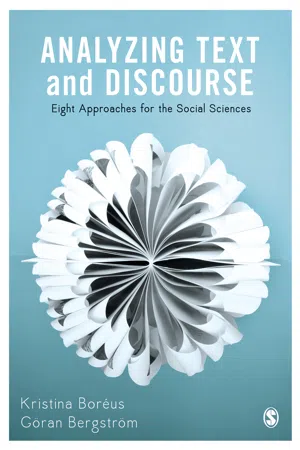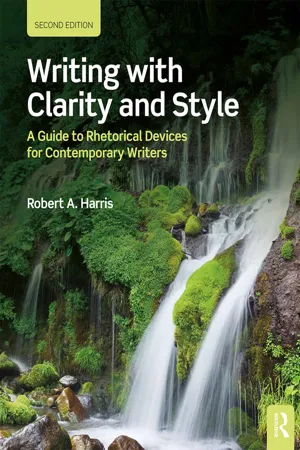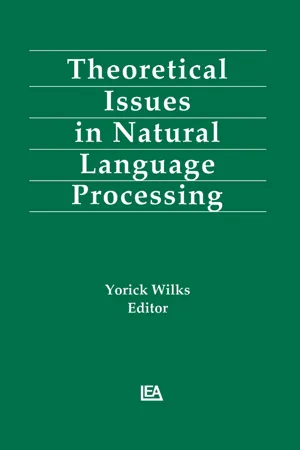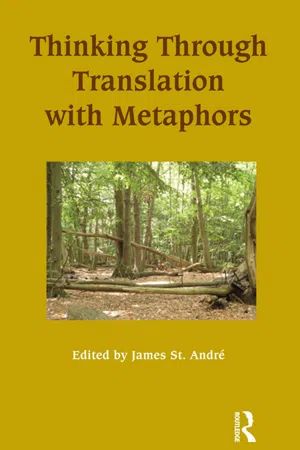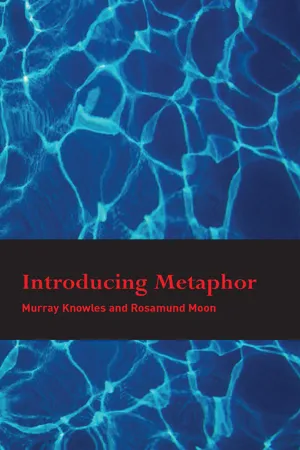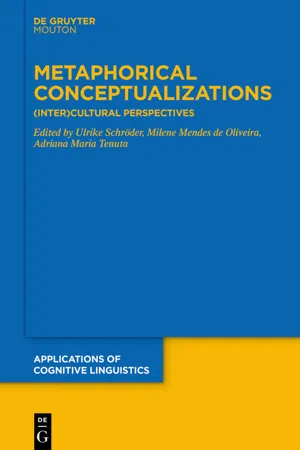Extended Metaphor
An extended metaphor is a literary device that draws out a comparison between two unlike things throughout a series of sentences or lines in a poem or prose. It allows for a deeper exploration of the comparison and can help to convey complex ideas or emotions. This technique is often used to create vivid imagery and enhance the reader's understanding of the subject.
7 Key excerpts on "Extended Metaphor"
- eBook - ePub
Analyzing Text and Discourse
Eight Approaches for the Social Sciences
- Kristina Boréus, Göran Bergström(Authors)
- 2017(Publication Date)
- SAGE Publications Ltd(Publisher)
...Thus, despite possible tensions between these approaches on a theoretical level, they can be used together in the broader frames of discourse analysis. One author who merges critical discourse analysis with the kind of metaphor analysis presented in this chapter is Charteris-Black (2004) who refers to his analysis as ‘Critical Metaphor Analysis’. With a war metaphor of his own making he refers to the analysis of metaphors as “an important weapon in the armoury of the critical discourse analyst” (2004: 86). 6.2 Analysis 6.2.1 Metaphors we live by To “see the light at the end of the tunnel” and to have “a long road ahead” might be (and usually are) metaphors. A metaphor describes something as something else that it is not, transferring meaning from one domain to another. This transfer is usually made from an area that is well known and tangible to what is less apparent to our senses and more abstract. If to “see the light at the end of the tunnel” is metaphorically meant, it refers to having found the solution to a difficult task or problem or that a difficult situation is coming to an end. The transfer here is probably of more than one aspect of the experience of moving in a tunnel: the darkness of the tunnel is the difficult or disturbing situation, the light at the end is the experience of knowing that things will be right again, while the idea of the tunnel itself might transfer the experience of confinement onto the experience of not getting away from struggling with a problem. Figurative language Metaphorical language is just one kind of figurative language. Similes, e.g. “families are like fudge”, are close to metaphors but differ in that they state explicitly that there is a transfer of ideas. A metonym is an expression used for something that it is a part of or in other ways associated with. “The White House claims” is seldom a literal statement – it does not mean that a building has started to talk...
- eBook - ePub
Writing with Clarity and Style
A Guide to Rhetorical Devices for Contemporary Writers
- Robert A. Harris(Author)
- 2017(Publication Date)
- Routledge(Publisher)
...8 Figurative Language I All of the rhetorical devices I have discussed are important to know and use, but the single, truly essential one to study until you gain proficiency is metaphor. —Aristotle Clarifying the unfamiliar by comparing it with the familiar is one of the key methods of teaching and learning. All of us try to understand something we don’t know about by comparing it to something we do know about. The devices presented in this and the following two chapters all embody this method, for they are all devices of association. An idea under discussion is illuminated or made more vivid through an imaginative comparison with something already familiar to the reader. These devices are among the most creative tools available to a writer because they frequently rely on novel comparisons and images, both of which make for a fresher, more vivid work. Simile A simile (SIM uh lee) compares two very different things that have at least one quality in common. While similes are used in poetry principally for artistic effect, in formal writing they serve not only to increase interest but also to clarify an idea in an imaginative way. After long exposure to the direct sun, the leaves of the houseplant looked like pieces of overcooked bacon. In the simile above, the subject to be compared is the leaves of the houseplant, while the image used is pieces of overcooked bacon. The word that directly expresses the comparison is like. In this instance, the writer wanted to emphasize the shriveled and brown look of the leaves, so a familiar, vivid image was chosen. Most people know what overcooked bacon looks like, so the image effectively presents a visual idea to the mind’s eye. Similes are imaginative comparisons between two fundamentally different things, not between genuinely similar ones. In fact, if the things compared are too much like each other, the comparison is not a simile...
- eBook - ePub
- Rainer Guldin(Author)
- 2015(Publication Date)
- Routledge(Publisher)
...At the one end, classical rhetoric defines metaphor as a single-word figure of speech, a trope of resemblance operating through displacement. At the other, cognitive linguistics claims that everyday speech, scientific discourse and the very way we think and act are fundamentally metaphorical in nature. These different conceptions will play an important role in the following chapters. They influenced the changing attitudes towards the notion of metaphor and the use of translation metaphors within the field of translation studies (Chapters 2 and 3), as well as the various metaphorical uses of translation within other disciplinary areas (Chapters 3, 4 and 5). Sections 8 and 9 consider the close relationship between metaphor and translation and the theoretical parallels in the development of metaphor theory and translation theory in the West. This connection is pivotal for the present book. It highlights the fact that a sustained study of metaphors for translation and of translation metaphors can be profitable for the fields of both translation studies and metaphor studies. 1 Transference and Analogy: Aristotle’s Definition of Metaphor Aristotle formulated the first substantial discussion of metaphor in the Western tradition. Although he discussed metaphor in only a few short paragraphs of his Poetics (2007) and Rhetoric (2011), his comments proved extremely influential. In Section 3, Part XXI of his Poetics, Aristotle draws a distinction between current or ordinary words that are in general use and strange, alien words that are in use in other countries. He positions metaphorical words between strange and ornamental words, suggesting their common exceptional character. The enumeration (Ricœur 2003: 19) that follows – newly coined, lengthened, contracted and altered words – reinforces the closeness of metaphor to that which is uncommon and outlandish...
- Yorick Wilks, Yorick Wilks(Authors)
- 2018(Publication Date)
- Psychology Press(Publisher)
...Metaphorical language was thought to be merely ornamental—the seasoning of language, exploited for effect by poets and politicians, 1 as compared with the cold factual language of the scientist. This view, however, is now no longer accepted (see, for example, Centner, 1982; Boyd, 1979). It is now assumed, at least by psychologists and linguists, that metaphors, and their close cousins, analogies, are important tools of cognition and communication, providing us with unfamiliar ways of conceptualizing familiar things, and familiar ways of conceptualizing unfamiliar things (Lakoiff & Johnson, 1980; Ortony, 1979; Vosniadou & Ortony, in preparation). Yet, what is still assumed, rather than demonstrated, is that nonliteral uses of language are sometimes necessary for accomplishing such goals, rather than merely convenient or elegant ways of doing so. In this paper we present a sort of empirical existence proof that there are some things whose descriptions appear to invoke much more use of metaphorical language than others. This, while not establishing the necessity of metaphors, certainly is a first step. In theory, there are at least three communicative functions that metaphor might serve (Ortony, 1975). First, they might allow one to express that which is difficult or impossible to express if one is restricted to literal uses of language. Evidence for this 'inexpressibility' claim would constitute encouraging support for the necessity-of-metaphors view. A second possible function of metaphors is that they may constitute a particularly compact means of communication. Although conscious experience is continuous in form, the linguistic system we use to talk about is comprised of discrete elements (lexical items). Unlike more literal forms of language, metaphor may enable us to convey a great deal of information in a succinct manner by obviating the need to isolate the predicates to be expressed into their corresponding lexical representations...
- eBook - ePub
- James St.Andre, James St.Andre(Authors)
- 2014(Publication Date)
- Routledge(Publisher)
...In Aristotle’s description, according to Cheyfitz, metaphor and translation (Cheyfitz 1991:36) are intimately linked: figurative language is made up of translated words of which metaphor itself is the prime example. Everyday language contains current and proper words, as well as metaphorical and strange words. Although Aristotle initially distinguishes metaphors from unusual words, he finally subsumes them under the same species of the foreign. By blurring the frontier between the metaphorical and the foreign a further link between metaphor and translation is introduced. that the same word, metaphero, can refer to either the translation of one language into another or the transference of sense within a language is not simply what brings the idea of metaphor within the context of translation or the idea of translation within the context of metaphor. For as Aristotle’s definition of metaphor suggests with its notion of the ‘transference’ of an ‘alien name’ into a familiar context, the very idea of metaphor seems to find its ground in a kind of territorial imperative, in a division, that is, between the domestic and the foreign. (ibid.:35-6) Metaphor and translation are, therefore, not only intimately linked to each other because of their structural analogy, that is, because of the existence of two separate entities between which a process of transference takes place. There is another more decisive similarity between that which is known and that which is unknown, the familiar and the unfamiliar. Metaphor is an alien element within everyday language, the same way a foreign language is for domestic speech. In the following passage Cheyfitz highlights another connection between metaphor and translation that reasserts their dialogical relationship. The translated text as a metaphor of the original can turn the original into a translation of itself...
- eBook - ePub
- Murray Knowles, Rosamund Moon(Authors)
- 2004(Publication Date)
- Routledge(Publisher)
...6 METAPHOR ACROSS LANGUAGES So far, we have been considering metaphor and metonymy in relation to English. In this chapter, we will look at how they work crosslinguistically in other languages and cultures. This has practical importance in relation to language learning and translation, and is also significant in relation to more abstract issues of language, culture, and thought. FIGURATIVE AWARENESS We have commented that in normal circumstances we are unaware of the figurativeness of conventional metaphors and metonyms: we simply use them as we would ordinary non-figurative meanings or words. We have also commented that figurative competence in children develops over a period of several years: while very young children can only process literal meanings, children of ten or twelve can generally handle most metaphorical usages in non-literary language. However, this applies to the acquisition of a first language, and not a foreign language. Foreign language learning typically begins at an age when we are already competent with metaphor to a greater or lesser extent in our first language. Furthermore, in learning the vocabulary of another language, we may well notice that items are metaphorical, even if the metaphors are conventional: we may also analyse compound items, and think of their literal, compositional meanings. As our comprehension and production of the other language become automatic, this heightened figurative consciousness is likely to fade until it is no stronger than that of native speakers. For example, when first learning that the French word for ‘potato’ is pomme de terre, we may analyse it as ‘apple of the ground’ and think of it as some kind of metaphor; similarly with German Eintopf ‘stew’, which literally means ‘one pot’ and is metonymic...
- eBook - ePub
Metaphorical Conceptualizations
(Inter)Cultural Perspectives
- Ulrike Schröder, Milene Mendes de Oliveira, Adriana Maria Tenuta, Ulrike Schröder, Milene Mendes de Oliveira, Adriana Maria Tenuta(Authors)
- 2022(Publication Date)
- De Gruyter Mouton(Publisher)
...In a way, when we use a metaphor, everything is already decided: we have stable mappings between the two domains, and there are metaphorical conventionalized linguistic expressions associated with those mappings. The production of metaphor is simply a process of selecting a linguistic metaphor that is attached to the mapping relevant to the situation at hand. Second, if conceptual metaphors are based on universal embodiment, the idea of universal meaning, or universal meaningfulness, preempts the possibility for contextual-cultural influence on metaphorical meaning making. I believe we can get around these difficulties if we work with the new conception of conceptual metaphor I call “extended conceptual metaphor theory,” or extended CMT, for short (Kövecses 2020). Two pillars of the new conception are that, first, it is a “multilevel” view of conceptual metaphor and that, second, it has a robust contextual component. What I do in the following sections is spell out some of the relevant details of this view and note, as we go along, how cognition and context, in general, and metaphor and cultural context, in particular, interact. I first describe the multilevel nature of conceptual metaphors, and then turn to its contextual component and how the multilevel and the contextual aspects are interlocked with each other in specific usage events. 2 The multilevel aspect of extended CMT Following a long line of researchers (Rosch 1978 ; Lakoff 1987 ; Langacker 1987), in essence, this is what I suggest: Much of our knowledge about the world comes in large systems of concepts organized into hierarchies at various levels (superordinate level, basic level, subordinate level). The systems of concepts so connected are related by schematicity...
